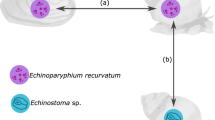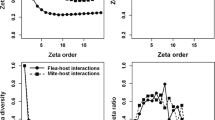Abstract
Natural enemies can be a powerful force when structuring natural communities, and in facilitating or preventing species coexistence depending on the nature of the trophic interaction. In particular, “keystone” predators can promote species coexistence, provided they preferentially attack the competitively dominant species. However, it is not clear whether parasites can play a similar structuring role; parasites typically form chronic associations with their victims, reducing their fitness (i.e., fecundity) rather than survival, and allowing infected hosts to remain viable competitors within the community. Therefore the density-dependent suppression of the host is likely to be more subtle than that due to predation. Using a series of simple population-dynamic models we show that specialist parasites can facilitate species coexistence, although possibly less so than predators. These results contrast with those typically found with models of generalist parasites, which can reduce the likelihood of species coexistence through apparent competition. In addition, we show that the likelihood of parasite-facilitated species coexistence depends greatly on the specific type of parasite. In particular, macroparasites (e.g., parasitic helminths) may be less likely to facilitate species coexistence than microparasites (e.g., viruses or bacteria) due to their typically highly aggregated distribution amongst their hosts. Furthermore, species coexistence is more likely if the parasite is relatively benign to its host. Parasitism by apparently “harmless” specialist parasites may provide an important but overlooked factor in the maintenance of species diversity, facilitating species invasions into new communities and the emergence of novel infectious diseases.






Similar content being viewed by others
References
Anderson RM, May RM (1978) Regulation and stability of host–parasite population interactions. I. Regulatory processes. J Anim Ecol 47:219–247
Begon M, Bowers RG, Kadiankis N, Hodgkinson DE (1992) Disease and community structure: the importance of host self-regulation in a host–host–pathogen model. Am Nat 139:1131–1150
Begon M, Harper JL, Townsend CR (1996) Ecology: individuals, populations and communities. Blackwell, Oxford
Bonsall MB, Hassell MP (1997) Apparent competition structures ecological assemblages. Nature 388:371–373
Charleston MA, Robertson DL (2002) Preferential host switching by primate lentiviruses can account for phylogenetic similarity with the primate phylogeny. Syst Biol 51:528–535
Gibson CC, Watkinson AR (1991) Host selectivity and the mediation of competition by the root hemiparasite Rhinanthus minor. Oecologia 86:81–87
Greenman JV, Hudson PJ (2000) Parasite-mediated and direct competition in a two-host shared macroparasite system. Theor Popul Biol 57:13–34
Hamilton WD, Axelrod R, Tanese R (1990) Sexual reproduction as an adaptation to resist parasites (a review). Proc Natl Acad Sci USA 87:3566–3573
Holt RD, Dobson AP (2006) Extending the principles of community ecology to address the epidemiology of host–pathogen systems. In: Collinge SK, Ray C (eds) Disease ecology: community structure and pathogen dynamics. Oxford University Press, Oxford, pp 6–27
Holt RD, Lawton JH (1993) Apparent competition and enemy-free space in insect host-parasitoid communities. Am Nat 142:623–645
Holt RD, Lawton JH (1994) The ecological consequences of shared natural enemies. Annu Rev Ecol Syst 25:495–520
Holt RD, Pickering J (1985) Infectious disease and species coexistence: a model of Lotka-Volterra form. Am Nat 126:196–211
Kiesecker JM, Blaustein AR (1999) Pathogen reverses competition between larval amphibians. Ecology 80:2442–2448
Kirlinger G (1986) Permanence in Lotka-Volterra equations: linked prey–predator systems. Math Biosci 82:165–191
May RM, Anderson RM (1978) Regulation and stability of host–parasite population interactions. II. Destabilizing processes. J Anim Ecol 47:249–267
Menge BA, Berlow EL, Blanchette CA, Navarrete SA, Yamada SB (1994) The keystone species concept: variation in interaction strength in a rocky intertidal habitat. Ecol Monogr 64:249–286
Mills OS, Soule ME, Doak DF (1993) The keystone species concept in ecology and conservation. Bioscience 43:219–224
Mitchell CE, Power AG (2003) Release of invasive plants from fungal and viral pathogens. Nature 421:625–627
Packer A, Clay K (2000) Soil pathogens and spatial patterns of seedling mortality in a temperate tree. Nature 404:278–281
Paine RT (1966) Food web complexity and species diversity. Am Nat 100:65–75
Park T (1948) Experimental studies of interspecies competition.1. Competition between populations of the flour beetles, Tribolium confusum Duval and Tribolium castaneum Herbst. Ecol Monogr 18:265–307
Piexoto ID, Abramson G (2006) The effect of biodiversity on the hantavirus epizootic. Ecology 87:873–879
Risch SJ, Carroll CR (1982) Effect of a keystone predaceous ant, Solenopsis geminata, on arthropods in a tropical agroecosystem. Ecology 63:1979–1983
Schall JJ (1992) Parasite-mediated competition in Anolis lizards. Oecologia 92:58–64
Schreiber SJ (1997) Generalist and specialist predators that mediate permanence in ecological communities. J Math Biol 36:133–148
Shaw DJ, Dobson AP (1995) Patterns of macroparasite abundance and aggregation in wildlife populations: a quantitative review. Parasitology 111:S111–S133
Shaw DJ, Grenfell BT, Dobson AP (1998) Patterns of macroparasite aggregation in wildlife host populations. Parasitology 117:597–610
Torchin ME, Lafferty KD, Dobson AP, McKenzie VJ, Kuris AM (2003) Introduced species and their missing parasites. Nature 421:628–630
Vance RR (1978) Predation and resource partitioning in one predator–two prey model communities. Am Nat 112:797–813
Vandermeer J, Maruca S (1998) Indirect effects with a keystone predator: coexistence and chaos. Theor Popul Biol 54:38–43
Yan GY (1996) Parasite-mediated competition: a model of directly transmitted macroparasites. Am Nat 148:1089–1112
Acknowledgments
A. Fenton was funded by a fellowship from NERC (UK). We also acknowledge funding from the Royal Society (UK) and the Wellcome Trust (UK). We are grateful to Angus Buckling for fruitful discussions.
Author information
Authors and Affiliations
Corresponding author
Appendix
Appendix
Analysis of the models used in this paper follow standard lines, and here we present in detail the mathematical details for the analysis of the simple two-host-one-parasite model (model 1). Solving model 1 reveals there are six possible equilibria:
-
E0 = (0,0,0)
-
E1 = (K 1,0,0)
-
E2 = (0,K 2,0)
-
E3 = (U 1*1 ,N 1*2 ,0)
-
E4 = (U 2*1 ,0,I *1 )
-
E5 = (U C*1 ,N C*2 ,I C*1 )
where
The Jacobian of model 1 is
where the Ωs are the eigenvalues of the system.
It is clear that the trivial solution E0 is always unstable. The characteristic equation at E1 is
Therefore, for stability of E1 we require:
Similarly, the characteristic equation at E2 is
and so stability of E2 requires:
Criteria 1 and 2 are the stability criteria for the simple Lotka-Volterra model with no parasite. If one or the other is fulfilled then that equilibrium is stable and the corresponding species wins. However, these criteria are not mutually exclusive—if both are fulfilled (i.e., 1/α 21 < K 1/K 2 < α 12) then bistability occurs, and the winner is determined by their initial conditions. Hence, the full criteria for stability of E1 and E2 are K 1/K 2 > Max(1/α 21, α 12) and K 1/K 2 < Min(α 12, 1/α 21), respectively. Finally, in terms of stability in the absence of the parasite, examining the definitions for U 1*1 and N 1*2 shows that for E3 to be biologically possible we need 1/α 21 > K 1/K 2 > α 12 and 1 > α 21 α 12, which define stable species coexistence in the absence of the parasite. However, further examination of the Jacobian evaluated at E3 reveals an additional requirement for stability of E3:
If this criterion is fulfilled, then the parasite is unable to invade and the two species coexist alone.
Examining the expression for P* at E4 shows that for this state to be biologically plausible requires β 1 K 1 > γ 1. In other words, for the parasite to be able to persist, its maximum transmission rate (β 1 K 1) must exceed its rate of loss (γ 1). In addition, examining the Jacobian evaluated at E4 reveals an additional requirement for stability:
This is effectively the criterion for species 1 to out-compete species 2 in the absence of the parasite (i.e., K 1 > K 2/α 21), adjusted to take into account the burden of being infected by the parasite.
Finally, examining the definitions of N C*2 and I C*1 at E5 reveals the following criteria need to be fulfilled for stability of E5 (species coexistence in the presence of the parasite):
and
which are the reverse of criteria 3 and 4, effectively dictating that the parasite is able to invade but species 1 is not able to exclude species 2. Analysis of the corresponding Jacobian confirms that these criteria define the region of species coexistence in the presence of the parasite. In addition, stability of E5 requires that AB > C where A, B and C are coefficients of the characteristic equation Ω3 + AΩ2 + BΩ + C = 0 of the Jacobian evaluated at E5. Numerical simulations show that if this criterion is broken then the system undergoes sustained limit cycles.
Analysis of the host–macroparasite model
Analysis of the other models presented in this paper follow similar lines to those described above. We omit the details of those analyses for brevity, but provide here a brief outline of the analysis of the host–macroparasite model (model 2). Solving model 2 reveals there are five possible equilibria:
-
E1 = (K 1,0,0)
-
E2 = (0,K 2,0)
-
E3 = (N 1*1 ,N 1*2 ,0)
-
E4 = (N 2*1 ,0,P *1 )
-
E5 = (N C*1 ,N C*2 , P C*1 )
where
where θ = (1 + k)/k and φ = β1λ/ω. The Jacobian of model 2 is:
where the Ωs are the eigenvalues of the system. We then obtain the boundaries separating the regions of parameter space by evaluating the coefficients of the characteristic equation for each equilibrial state, as described for model 1 above.
About this article
Cite this article
Fenton, A., Brockhurst, M.A. The role of specialist parasites in structuring host communities. Ecol Res 23, 795–804 (2008). https://doi.org/10.1007/s11284-007-0440-6
Received:
Accepted:
Published:
Issue Date:
DOI: https://doi.org/10.1007/s11284-007-0440-6




